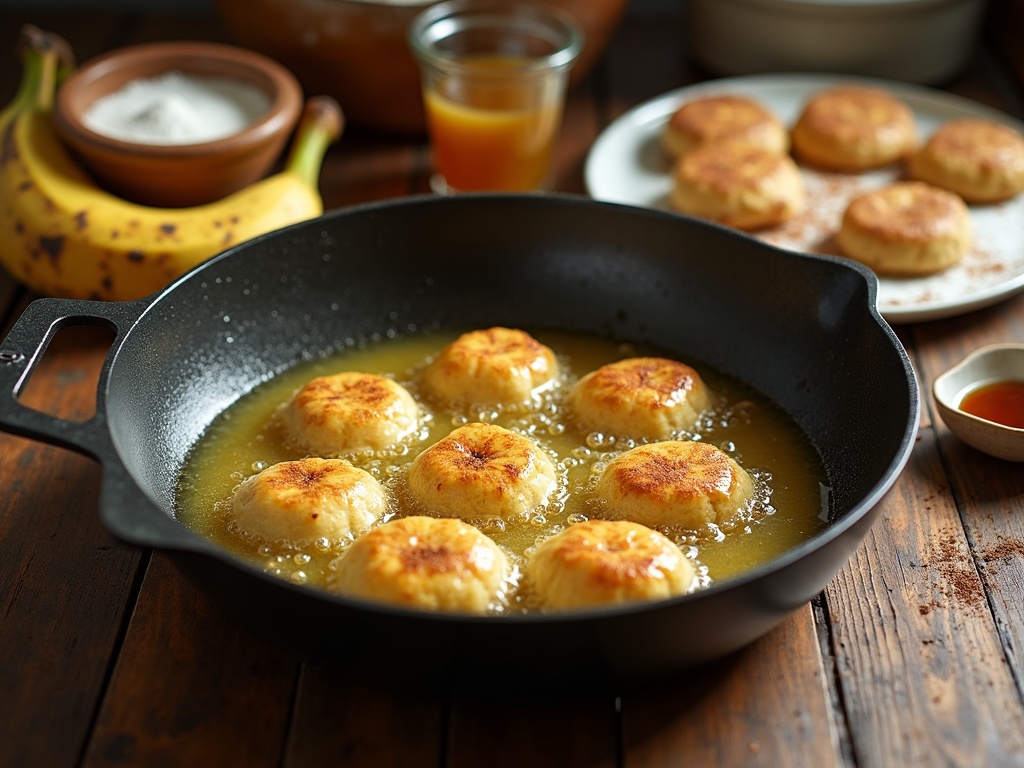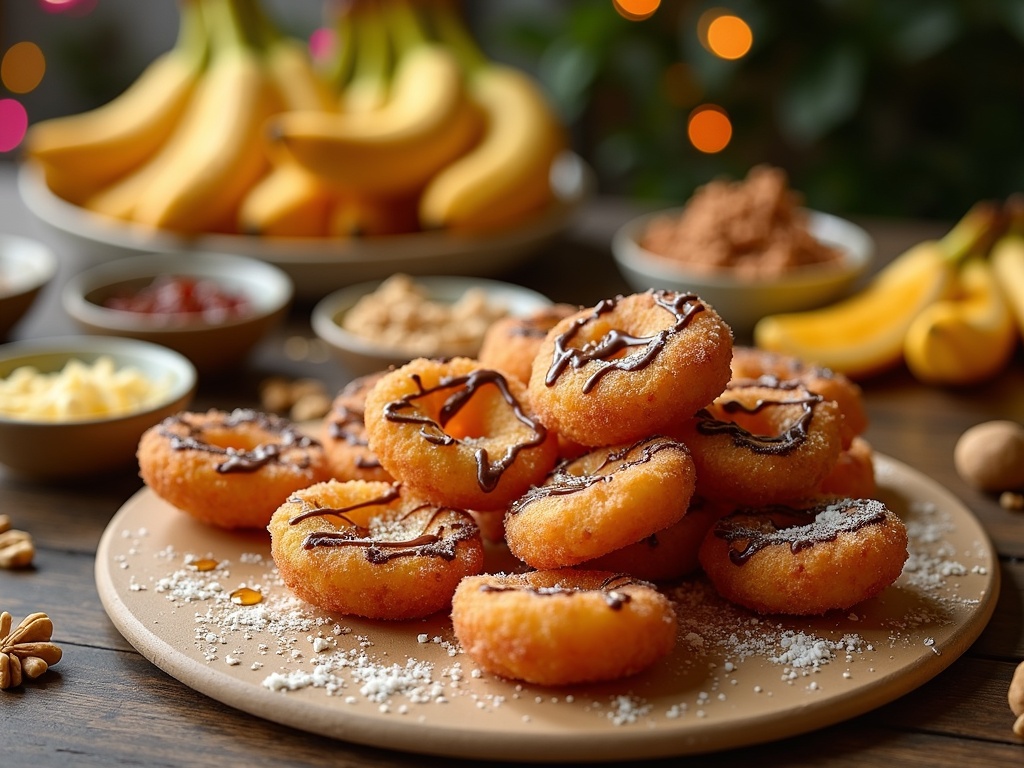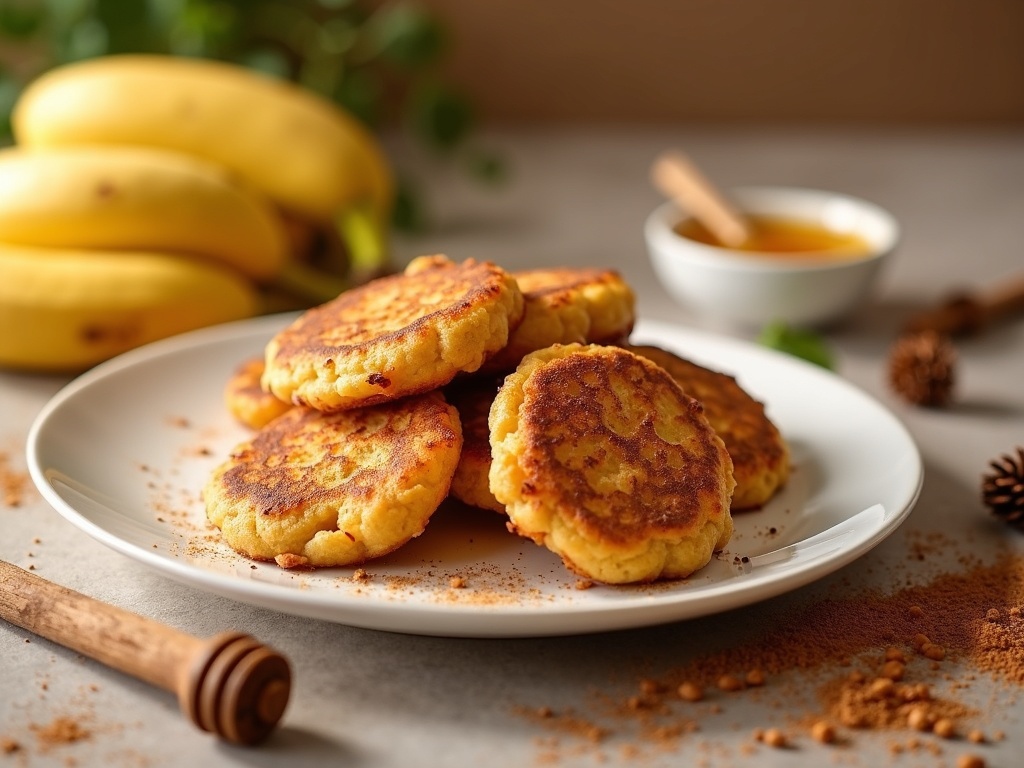Banana fritters have captured the culinary imagination of cultures across the globe, appearing as beloved street food in Southeast Asia, family celebration treats in the Caribbean, and in various forms throughout Africa and beyond. These golden-brown delights transform simple ingredients into a versatile dessert that balances crispy exteriors with soft, sweet interiors while reflecting local ingredients and traditions wherever they appear.
Find In This Article
Key Takeaways
- Banana fritters adapt to regional preferences, appearing as “pisang goreng” in Malaysia and Indonesia, often using rice flour for extra crispiness, while Caribbean versions might incorporate rum and spices.
- The basic recipe is accessible to home cooks, requiring just ripe bananas, flour, sugar, and baking powder, with options for baking or air-frying as healthier alternatives to traditional deep-frying.
- Creative customizations include adding coconut, nuts, or various spices, with serving options ranging from simple powdered sugar to elaborate toppings like chocolate sauce or ice cream.
- Despite being a fried treat, banana fritters offer nutritional benefits including potassium, vitamin C, and dietary fiber, with fewer calories than many other dessert options.
- These fritters hold cultural significance in many regions, featuring prominently in celebrations, family gatherings, and as popular street food that connects communities.
The Global Appeal of This Classic Fried Treat
I’ve noticed that banana fritters have captured hearts and palates across multiple continents, making them one of the most versatile desserts in global cuisine. These golden-brown delights consist of ripe bananas dipped in batter and fried until crispy on the outside while maintaining a soft, sweet interior.
Regional Variations and Flavors
Across Southeast Asia, banana fritters (often called “pisang goreng” in Malaysia and Indonesia) are a beloved street food, typically made with plantains or local banana varieties. The batter often includes rice flour for extra crispiness. In the Caribbean, these treats feature prominently at family gatherings, with many recipes incorporating rum and spiced batter recipes that highlight the region’s flavor profile.
African versions, particularly popular in West African countries, sometimes lean toward savory interpretations, with spices that complement the natural sweetness of the fruit. Each region’s take on this simple dish reflects local ingredients and culinary traditions.
The versatility of banana fritters extends to their flavor profiles as well. Common additions include:
- Warming spices like cinnamon and nutmeg that enhance the banana’s natural sweetness
- Vanilla extract for depth of flavor and aroma
- Coconut (either as flakes in the batter or as coconut milk for added richness)
- Honey or caramel drizzle for serving
- A light dusting of powdered sugar as a finishing touch
Cultural Significance
Banana fritters hold special cultural importance beyond just being a tasty snack. In many Southeast Asian countries, they’re a staple at morning markets, often paired with coffee or tea for breakfast. During Ramadan in Malaysia and Indonesia, these fritters frequently appear on iftar tables to break the day’s fast.
In the Caribbean, particularly Jamaica, banana fritters are associated with traditional holiday celebrations and family gatherings. The dish often represents resourcefulness, as it transforms overripe bananas into something delicious rather than letting them go to waste.
Street vendors across these regions have perfected the art of frying these treats to crispy perfection, creating a shared culinary experience that crosses cultural boundaries. Whether served as a sweet breakfast, afternoon snack, or dessert, banana fritters represent comfort food at its most accessible.
The beauty of this dish lies in its simplicity and adaptability. With just a few pantry staples and ripe bananas, anyone can create this delicious treat that connects culinary traditions from across the globe.
How You Can Make It
I’ve discovered that banana fritters are surprisingly easy to make once you know the fundamentals. The secret lies in using the right ingredients and maintaining proper cooking temperatures.
Basic Ingredients and Preparation
To make classic banana fritters, I start with overripe bananas—those with brown spots are perfect as they offer natural sweetness and mash easily. My basic recipe combines 2 mashed ripe bananas with 1 cup of flour, 2 tablespoons of sugar, and 1 teaspoon of baking powder. I sometimes add a pinch of cinnamon for extra flavor.
The consistency should be thick enough to coat the back of a spoon but still drop easily. If the batter is too thick, I add a splash of milk; if too thin, a bit more flour solves the problem. Once the batter is ready, I heat oil in a deep pan to exactly 350°F—this temperature is critical for achieving that golden exterior while fully cooking the inside.
Cooking Techniques for Perfect Results
When frying banana fritters, I drop tablespoon-sized portions of batter into the hot oil, being careful not to overcrowd the pan. This maintains the oil temperature and gives each fritter room to expand. For the crispiest texture, I flip them only once when the bottom edges turn golden brown—usually after about 2-3 minutes.
For those looking to reduce oil consumption, there are excellent alternatives to traditional frying:
- Baking: Place dollops of batter on a parchment-lined tray and bake at 375°F for 12-15 minutes
- Air-frying: Cook at 350°F for 8 minutes, flipping halfway through
- Pan-frying: Use minimal oil in a non-stick pan for a lighter version
After cooking, I place the fritters on paper towels to drain excess oil properly. For extra absorbency, I sometimes use a cooling rack over paper towels, which allows air to circulate and prevents the bottoms from becoming soggy.
These techniques work wonderfully for other sweet treats too—you might enjoy making crunchy biscuit varieties or trying your hand at a tangy cheesecake recipe using similar principles of temperature control.
The best banana fritters have a satisfying contrast between the crispy exterior and soft, banana-rich interior. When served warm with a dusting of powdered sugar or a drizzle of honey, they make a delightful citrus-complementing dessert that’s sure to impress.

Creative Ways to Serve and Customize
Banana fritters offer endless customization possibilities that can transform this simple treat into something extraordinary. I’ve discovered numerous creative approaches to elevate this classic dessert through both ingredients and presentation.
Global Variations and Flavor Combinations
The Caribbean version of banana fritters adds shredded coconut to the batter for tropical flair. Some recipes incorporate a splash of rum for an adult twist that enhances the banana’s natural sweetness. In Indonesia, ‘pisang goreng’ features a lighter, crispier batter that perfectly complements the soft banana interior.
Adding texture and complexity to your fritters is simple with these enhancements:
- Chopped walnuts or pecans for crunch and nutty depth
- Ground cardamom for a subtle aromatic quality
- Freshly grated nutmeg for warmth and complexity
- Cinnamon-sugar coating for a sweet finish
- Sesame seeds for visual appeal and light crunch
These additions work wonderfully with easy breakfast recipes and can be adjusted based on your personal preferences.
Serving and Presentation Ideas
The toppings you choose can completely transform your banana fritters. I often drizzle warm honey over freshly fried fritters for a natural sweetness that pairs perfectly with the banana. For chocolate lovers, a rich chocolate syrup creates an indulgent dessert experience, while homemade caramel sauce adds sophisticated sweetness.
For special occasions, consider creating a banana fritter bar where guests can customize their own treats. Arrange various toppings in small bowls around a platter of warm fritters. This interactive dessert station works perfectly for casual gatherings or even more formal events.
Regional customizations reflect local ingredient availability and cultural preferences. In Thailand, banana fritters might include pandan extract for color and flavor, while Mexican versions often incorporate a touch of cinnamon and sugar similar to churros.
For a refreshing contrast, serve warm banana fritters with a scoop of vanilla ice cream or alongside a tangy cheesecake for an interesting textural combination. During fall gatherings, I’ve found that banana fritters pair wonderfully with seasonal fruit crumbles to create a varied dessert offering.
The beauty of banana fritters lies in their versatility – they can be humble comfort food or dressed up for an elegant dessert presentation depending on how you choose to serve and customize them.

What’s Inside: Nutrition Facts
Banana fritters blend the natural goodness of bananas with the indulgence of fried dough, creating a treat that’s both satisfying and somewhat nutritious. A typical 100-gram serving contains between 150-250 calories, depending on the preparation method and ingredients used. These sweet treats provide approximately 2 grams of protein, 25 grams of carbohydrates, and 7 grams of fat per serving.
Unlike many desserts that offer little nutritional value, banana fritters actually deliver some important nutrients. They’re a good source of potassium, which helps regulate blood pressure and muscle function. They also contain vitamin C, supporting immune health, and dietary fiber for digestive wellness. The banana base means you’re getting more nutritional benefits than you’d find in many standard breakfast pastries or desserts.
How They Compare to Other Desserts
When looking at the nutritional profile, banana fritters stack up favorably against many popular desserts:
- Lower in calories than most cheesecake slices (300-400 calories per serving)
- Less sugar than frosted cakes or cookies
- Higher in beneficial nutrients than most candy or chocolate desserts
- More fiber than fruit crumbles that rely heavily on processed toppings
- Lower in refined carbohydrates than most commercial pastries
The cooking method significantly impacts the health profile of banana fritters. Deep-fried versions naturally contain more fat and calories, while air-fried or baked alternatives can reduce the fat content by up to 70%. The oil choice matters too – coconut oil adds medium-chain triglycerides, while vegetable oils contribute polyunsaturated fats.
I can create healthier versions of banana fritters with a few simple adjustments. Switching to whole grain flour adds more fiber and nutrients, while using natural sweeteners like honey reduces refined sugar. Adding spices like cinnamon not only enhances flavor but can help regulate blood sugar. Using an air fryer or baking the fritters drastically cuts down on oil absorption while maintaining that crispy exterior everyone loves.
The ripeness of bananas used also affects nutrition – riper bananas have more natural sugars but also more antioxidants and can allow for less added sugar in the recipe.

Cultural Significance Around the World
Banana fritters hold a special place in culinary traditions across multiple continents, each region adding its unique twist to this beloved treat. I’ve discovered that these golden, crispy delights transcend mere snacking—they’re woven into the cultural fabric of many societies.
Global Celebrations and Traditions
In many African countries, banana fritters serve as a staple street food, where vendors fry them fresh at bustling markets and roadside stalls. The aroma of these sizzling treats often signals a gathering spot for locals and tourists alike. Countries like Ghana and Nigeria feature variations with specific spice blends that showcase their distinct culinary heritage.
Indonesian children particularly treasure banana fritters, locally known as “pisang goreng,” as an after-school snack. Families prepare these treats using local banana varieties that offer a perfect balance of sweetness when fried. This connection to childhood makes banana fritter recipes popular family favorites passed down through generations.
The significance of banana fritters extends to cultural celebrations worldwide:
- During harvest festivals in Caribbean nations, these fritters feature prominently alongside other banana-based dishes
- In Thailand’s floating markets, vendors prepare banana fritters from boats, creating a unique cultural experience
- Brazilian celebrations often include banana fritters during Carnival season
- Filipino family gatherings typically offer banana fritters as a cherished dessert option
What fascinates me about these humble fritters is how they’ve integrated into regional cuisines while maintaining their essential character. In India, they’re often spiced with cardamom and served with traditional sweets like Mysore pak during celebrations. Southeast Asian versions frequently incorporate coconut for added texture and flavor, while Caribbean preparations might include rum-soaked raisins.
The cultural importance of banana fritters also connects to global agricultural patterns. Major banana-producing regions have developed the most diverse fritter traditions, creating economic and culinary synergies. This relationship has spawned countless regional adaptations, from the citrus-infused variations in Mediterranean countries to the cinnamon-dusted versions popular in Latin America.
Whether enjoyed as a quick street snack, festive treat, or family dessert, banana fritters demonstrate how a simple preparation can bridge cultural divides while maintaining deep local significance.
Sources:
Healthline, Bananas
The Spruce Eats, Banana Fritters: History
Journal of Nutrition and Metabolism, Fried Food Health

